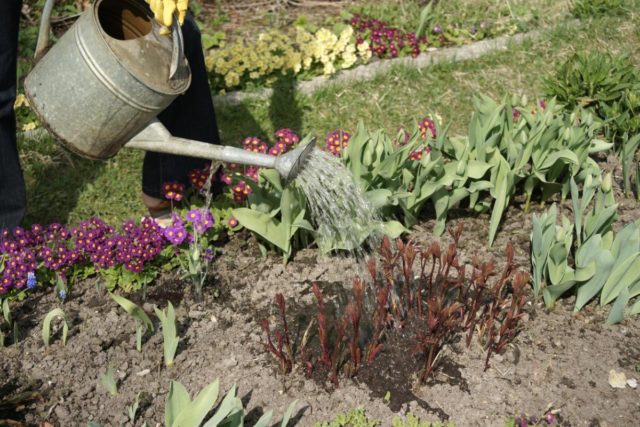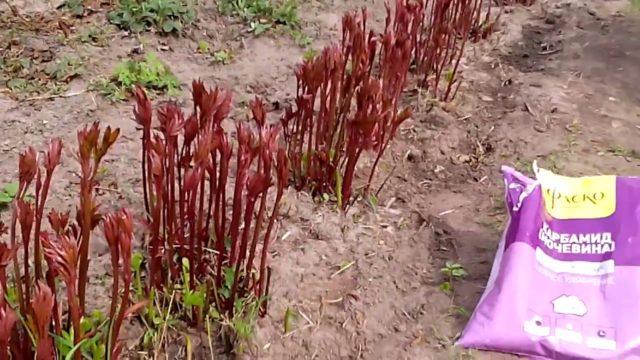Content
Caring for peonies in spring is a guarantee of active and lush flowering of these plants in summer. The first activities are usually carried out after the snow melts in the garden, and young shoots begin to appear in the beds. In the spring, it is important to properly release the peonies from the shelter, organize them the correct watering and fertilizing regime, properly loosen and mulch the soil. It is also necessary to take care of the health of the bushes, paying attention to preventive treatment against diseases. The complex of care measures started in spring should be continued in summer, when the plants have already bloomed. If you follow all the recommendations given by experienced gardeners and follow their advice, peonies on the site will remain beautiful, healthy and lush blooming for more than a dozen years.
Caring for peonies after winter
It is necessary to start caring for peonies in the spring in the country or garden area even before the first shoots appear on the beds. First of all, they remove the shelter from the plantings, examine the condition of the bushes after winter, remove dry shoots and debris from the beds. In spring, peonies sprout, then leaves, buds and, finally, flowering begins. At this stage, they begin to systematically water and feed them, as well as loosen the soil and, if necessary, get rid of weeds.

Peony care in the spring begins even before the appearance of young sprouts in the beds
When and how to open peonies after winter
Spring care for peonies growing on the site usually begins with the removal of the covering material, which provided the plants wintering in the open ground with protection from frost and low temperatures. It is necessary to remove the shelter from the landings after waiting for the snow to melt, thawing of the soil and the cessation of recurrent night frosts.
This must be done gradually:
- First, you need to carefully remove the mulch (dry foliage, sawdust) from the root collar of the peony, lifting the layer of coniferous spruce branches or agrofibre.
- The upper shelter should be removed a little later, making sure that a stable "positive" temperature has been established and giving the plants the opportunity to gradually get used to the surrounding conditions.
- If dry stems are found under the shelter that have remained from last year due to insufficiently low pruning of the bush, they should be removed so that the new generation of young shoots can grow freely.
- Further care consists in removing debris and lumps of hardened soil from the beds, as well as gently loosening the soil between the small reddish shoots.
First watering and feeding
An important stage in caring for peonies in the spring in the country is the organization of abundant watering. At the stage of bud formation, shoot and leaf growth, plants require a large amount of moisture, so the gardener must make sure that there is enough moisture.

In spring and summer, peonies need regular, not very frequent, but plentiful watering.
Caring for peonies in the form of regular watering should be started when dry weather is established. As a rule, it is enough to perform this procedure once every 7-10 days, spending from 2 to 5 buckets of water for each bush, depending on its size.
Basic Rules:
- prevent the soil from drying out under the peonies and the formation of a hard crust on its surface;
- it is desirable that the water is warm;
- when watering, moisture should not get on the leaves of the plant;
- it is advisable to make holes around the bushes so that the water soaks the soil better;
- caring for the soil at the roots after watering consists in its obligatory loosening to ensure better access of oxygen;
- it is necessary to water the peonies before the beginning of September.
Mandatory measures for caring for peonies in the spring include feeding the bushes with organic and mineral substances. The approximate order of fertilization is as follows:
- At the stage of swelling of the shoots, approximately at the end of March, rotted manure (5 l) or a complex nitrogen-potassium composition (20 g) is embedded in the soil under each bush of peonies. Fertilizer is evenly distributed inside the hole at a distance of about 15-20 cm from the plant itself. After that, the soil is dug to the depth of the shovel bayonet, covered with a 4-cm layer of compost to retain moisture and watered with clean water.
- 20 days later, the peonies are fed with complex mineral compositions. You can choose a ready-made fertilizer with a predominant content of phosphorus and potassium, or prepare the mixture yourself by dissolving 10 g of ammonium nitrate, 20 g of potassium salt and 30 g of superphosphate in a bucket of water.
- After the appearance of the first shoots, it is advisable to diversify the care of peonies by introducing foliar dressings. It is advised to spray shoots and leaves three times per season with an interval of 10-15 days. Initially, it is recommended to use an aqueous solution of urea (40 g per bucket), then the same composition with the addition of a tablet with microelements, and, finally, only microelements dissolved in water.

In the spring-summer period, it is important to properly organize the introduction of root and foliar dressings.
How to care for peonies in spring and summer
Caring for peonies in the summer is largely a continuation of the activities started in the spring. It also aims to maintain the health of the bush and achieve its abundant flowering.
Preventive treatments
When caring for peonies in spring and summer, one should not forget about disease prevention.
So, the first treatment against fungi is carried out immediately after the snow melts, watering the soil with a solution of potassium permanganate (1-2 g per 5 l of water).
At the stage of leaf unfolding in mid-May, the prevention of damage to peonies by borotrix, or gray rot, is performed by spraying the plant and the soil around the bush with solutions of copper preparations (HOM, copper sulfate, Borodos mixture 0.5%).
The second treatment with the same preparations against gray rot and rust is carried out in 10-15 days.
Caring for peonies involves another spraying with fungicides - after the end of flowering.
Loosening and mulching of the soil
A set of measures for the care of peonies in the spring in the country or in an open garden plot also includes systematic loosening of the soil. Usually it is performed using a flat cutter or cultivator, stepping back about 3-5 cm from the shoots of the bush. It is necessary to loosen the soil to a depth of 5 cm, carefully so as not to damage the shoots.
The rules for caring for peonies in spring and summer involve loosening the soil after each watering or heavy rain, in parallel with the removal of weeds (if necessary). It is also recommended to make sure to perform this action:
- in mid-April, after the mass emergence of seedlings;
- in mid or late May, when budding begins;
- at the beginning of August.

Every time after watering or rain, you should carefully loosen the soil under the peony bushes.
Mulching the soil in spring is advised to better retain moisture and heat, as well as prevent weeds. For these purposes, it is best to use a small layer of rotted manure. Straw or rotted leaves are also often used, but they can cause an outbreak of fungal diseases.
Tips from seasoned gardeners for the care of peonies in the spring
It is worth taking into account some additional recommendations of experienced gardeners, how to care for peonies in the spring, so that they grow well and bloom luxuriantly:
- if a lot of water appears during the period of snow melting, it is advisable to temporarily dig special drying grooves near the peony bushes, which will take excess moisture away from the roots;
- it is recommended to remove the upper shelter in early spring in cloudy weather in order to avoid sharp exposure to sunlight on young shoots;
- watering peonies is best in the early morning or evening, after waiting for the sun to set;
- while feeding along the sheet, you can add a little soap or washing powder to the composition so that the drops do not roll down too quickly;
- to avoid breaking off shoots in strong winds, bushes of herbaceous peonies or those that give large flowers are usually surrounded by a strong support of pegs with crossbars;
- Experienced gardeners do not advise tying up peony shoots, since because of this, most of the buds may simply not open;
- in order for the flowers to be large and lush, at the end of May, about a third of the ovaries are usually removed, and the lateral buds are also cut off.

Strong support around the peony bush will prevent the shoots from breaking from strong winds or under the weight of flowers
You can also learn about the main secrets and intricacies of caring for peonies in spring from the video:
Conclusion
Caring for peonies in spring and summer consists in gradually removing the winter shelter and cleaning the beds, organizing systematic watering, introducing root and foliar dressings, and preventing the most common diseases. The soil under the bushes must be mulched and periodically loosened, and if necessary weed out. For the best flowering, it is recommended to remove part of the ovaries at the end of spring, and in order to preserve the integrity of the shoots, it is advisable to build a strong and comfortable support for the bushes. The measures and subtleties of caring for peonies in spring and summer, which are based on the experience of experienced gardeners, will help maintain the beauty and health of these plants in the backyard in order to admire their lush flowering for a long time.








